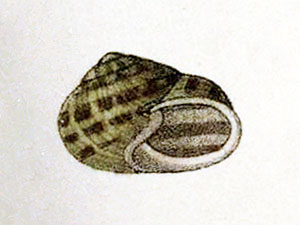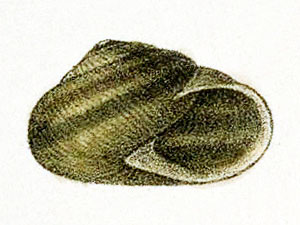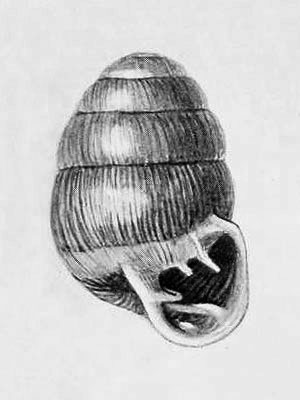Gran Canaria Napaeus Snail (Napaeus indifferens)
This species was described in 1872, known only by subfossil shells that look quite fresh, however, so it might have become extinct quite recently or might turn out to be still alive.
*********************
edited: 13.09.2020
Tag Archives: Canary Islands
Hemicycla montefortiana Beck & Rähle
Monteforte Land Snail (Hemicycla montefortiana)
This species was described in 2006, its (sub)fossil shells were found in fossil beds in the Barranco de Monforte on the island of La Gomera, Canary Islands.
The shells reach sizes of about 4,6 cm in diameter, they are very similar to those of another extinct member of this genus, Mousson’s Land Snail (Hemicycla moussoniana (Wollaston)) but are larger. [1]
***
The fossil beds of La Gomera have been dated to Late Pleistocene to Holocene age, thus the Monteforte Land Snail may very well have survived into the Holocene.
*********************
References:
[1] T. Beck; W. Rähle: Description of a newly discovered extinct repreentative of the genus Hemicycla Swainson, 1840 (Gastropoda, Pulmonata, Helicidae) from La Gomera, Canary Islands. Basteria 70: 53-56. 2006
*********************
edited: 05.12.2018
Xerotricha garachicoensis (Wollaston)
The Garachico Snail was described in 1878; it is only known only from some specimens that were collected in 1861 from around Garachico, a city in northern Tenerife, Canary Islands.
“In its general size and hue, as well as in the proportion of its umbilicus, the P. garachicoensis has also, at first sight, a little in common with the P. Bertholdiana, Pfeiff., from the Cape Verdes. It is, however, more flattened and discoidal than that species (or less lenticular), its surface is more strongly and roughly sculptured, and, although the spire is much depressed, its volutions are nevertheless more tumid, – the basal one moreover being quite free from the slightest trace of a keel.” [1]
The habitat in the original locality has drastically changed since the 19th century and the species has not been recorded since its description and might well be extinct.
*********************
References:
[1] T. Vernon Wollaston: Testacea Atlantica: or the Land and Freshwater Shells of the Azores, Madeiras, Salvages, Canaries, Cape Verdes, and Saint Helena. London: L. Reeve & Co. 1878
[2] David T. Holyoak; Geraldine A. Holyoak; Yurena Yanes; Maria R. Alonso; Miguel Ibáñez: Taxonomic revision, habitats and biogeography of the land snail family Discidae (Gastropoda: Pulmonata) in the Canary Islands. Journal of Conchology 40(6): 583-603. 2011
*********************
edited: 12.05.2022
Hemicycla hedybia (Mabille)
Hedybia Land Snail (Hemicycla hedybia)
The Hedybia Land Snail was described in the year 1882, it is resp. was endemic to the Canary Islands, that is all that’s known, since the author (J. Mabille) did not mention any further data about the locality.
The species may quite well still exist.
*********************

(public domain)
*********************
edited: 17.10.2020
Hemicycla maugeana (Shuttleworth)
Valverde Land Snail (Hemicycla maugeana)
The quite variable Valverde Land Snail, described in 1852, was endemic to the island of El Hierro, Canary Islands, where it apparently was restricted exclusively to the lowland regions in the southern part of the island.
The species was not found during recent searches (around 2010) and may be extinct.
*********************

(public domain)
*********************
edited: 04.12.2018
Kunkeliella psilotoclada (Svent.) Stearn
Masca Brush Bush (Kunkeliella psilotoclada)
The species is now considered extinct, as the last two specimens were found in 1983. The main reasons for its extinction are found in the uncontrolled grazing by introduced goats and rabbits.
***
The other three species of the genus, the Gran Canaria Brush Bush (Kunkeliella canariensis Stearn) from the island of Gran Canaria as well as the Rue Brush Bush (Kunkeliella retamoides Santos) and the Fleshy Brush Bush (Kunkeliella subsucculenta Kämmer), both from Tenerife, are also extremely threatened.
*********************
References:
[1] Peter und Ingrid Schönfelder: Die Kosmos Kanarenflora. Franckh-Kosmos-Verlag Stuttgart 1997
[2] Thomas Abeli; Giulia Albani Rocchetti; Zoltan Barina; Ioannis Bazos; David Draper; Patrick Grillas; José María Iriondo; Emilio Laguna; Juan Carlos Moreno-Saiz; Fabrizio Bartolucci: Seventeen ‘extinct’ plant species back to conservation attention in Europe. Nature Plants 7: 282-286. 2021
*********************
edited: 13.11.2021
Hemicycla gomerensis (Morelet)
La Gomera Land Snail (Hemicycla gomerensis)
This species was described in 1864, it is or was endemic the the island of La Gomera, Canary Islands.
The shell reaches a size of about 2,1 cm in diameter.
“In proportion to its size the shell is extremely thin and fragile, being more than usually sub-diaphanous when held up to the light; and its colour is a deep castaneous-brwon, but rather paler (or more olivaceous) beneath, with extremely indistinct indications of three obsolete darker bands, – one of which is just below the dorsal line, another immediately above it, and the third a little behind the suture (the space between this last one and the suture being sometimes, apparently, though not in the specimens now before me, of a more lively ochreous yellow).” [1]
***
The La Gomera Snail is listed in the Red List of the IUCN as ‘data deficient’, but may be already extinct.
*********************
References:
[1] T. Vernon Wollaston: Testacea Atlantica: or the Land and Freshwater Shells of the Azores, Madeiras, Salvages, Canaries, Cape Verdes, and Saint Helena. London: L. Reeve & Co. 1878
*********************

(public domain)
*********************
edited: 05.12.2018
Hemicycla guanartemes (Grasset)
Guanarteme Land Snail (Hemicycla guanartemes)
This species was described in 1857, it is/was endemic to the island of Gran Canaria, Canary Islands.
The shell reaches/reached a size of about 2 cm in diameter.
***
The Guanarteme Land Snail appears to have been quite common formerly.:
“The present Helix was taken in Gran Canary both by Grasset and Fritsch, and subsequently in considerable abundance by Mr. Lowe and myself. We found it principally in and around the little town of Teror (on one occasion even within the house of Don Pedro Manrique), but likewise in the region of El Monte, – particularly in the hollows of old trees at the Laurealos, ….” [1]
***
The species is listed (as Hemicycla guamartemes) in the Red List of the IUCN as ‘data deficient’, but, since it apparently was not found during recent searches, may be already extinct.
*********************
References:
[1] T. Vernon Wollaston: Testacea Atlantica: or the Land and Freshwater Shells of the Azores, Madeiras, Salvages, Canaries, Cape Verdes, and Saint Helena. London: L. Reeve & Co. 1878
*********************

(public domain)
*********************
edited: 05.12.2018
Emberiza alcoveri Rando, Lopez & Segui
Long-legged Bunting (Emberiza alcoveri)
This species was described based on subfossil remains that had been found on the island of Tenerife, Canary Islands.
The Long-legged Bunting had very long legs and short wings, which indicate that the species may even have been flightless, if so it would have been one of only a very, very few passerines that lost their flight abilities.
The species disappeared shortly after the Canary Islands were settled by the Guanches at around 1000 BCE.
*********************
edited: 17.04.2019
Leiostyla castanea (Shuttleworth)
Chestnut-colored Helmet Snail (Leiostyla castanea)
The Chestnut-colored Helmet Snail was described in the year 1852, it appears to be or have been endemic to the island of Tenerife, Canary Islands.
The species was known to occur in damp places near Garachico, a town on the northern coast of Tenerife.
***
See Thomas Vernon Wollaston in the year 1878 (Testacea Atlantica).:
“Mr. Lowe’s examples of this very distinct Pupa were taken, during April of 1861, above Garachico, in the north of Teneriffe, – namely adhering to wet rocks and sodden leaves, in the drip of a small waterfall ….” [1]
***
The Chestnut-colored Helmet Snail was never recorded again since 1878 and appears to be extinct.
*********************
References:
[1] T. Vernon Wollaston: Testacea Atlantica: or the Land and Freshwater Shells of the Azores, Madeiras, Salvages, Canaries, Cape Verdes, and Saint Helena. London: L. Reeve & Co. 1878
*********************

(public domain)
*********************
edited: 17.01.2011
